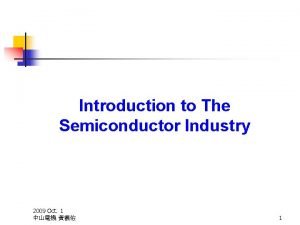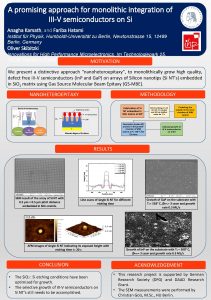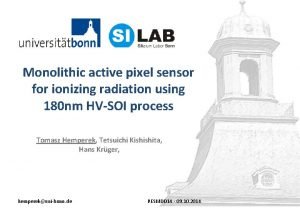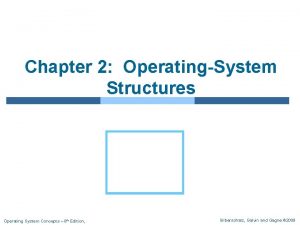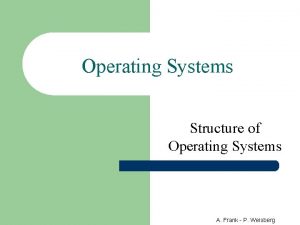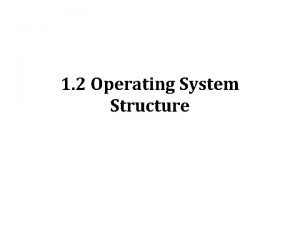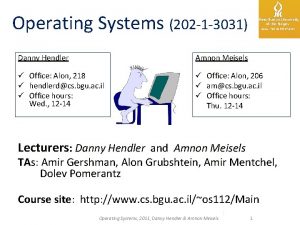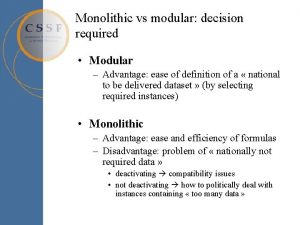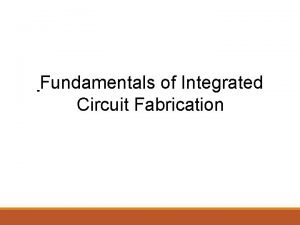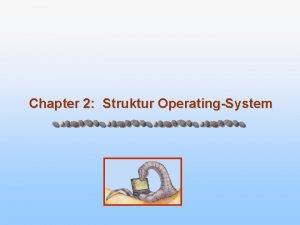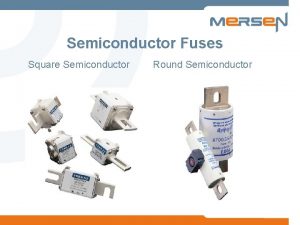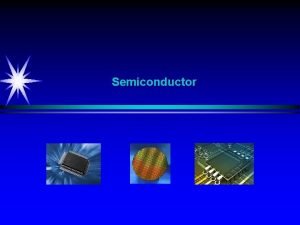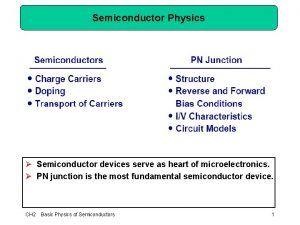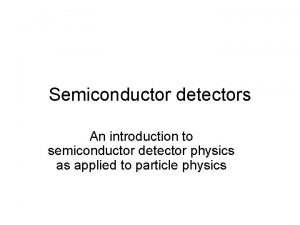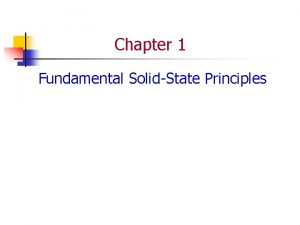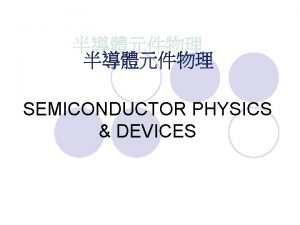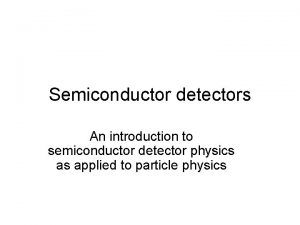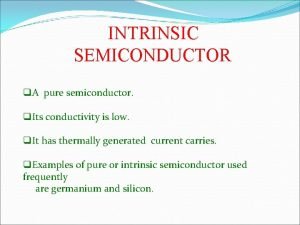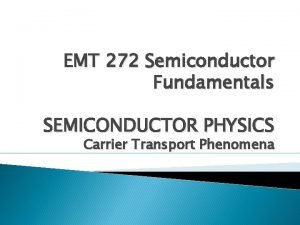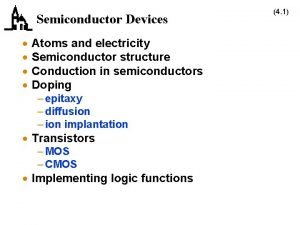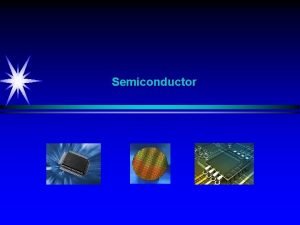A DISRUPTOR TO THE SEMICONDUCTOR INDUSTRY THE MONOLITHIC



























































- Slides: 59

A DISRUPTOR TO THE SEMICONDUCTOR INDUSTRY THE MONOLITHIC 3 D-IC Monolith. IC 3 D Inc. Patents Pending 1

Semiconductor Industry is Facing an Inflection Point Dimensional Scaling has reached Diminishing Returns

The Current 2 D-IC is Facing Escalating Challenges - I Ø On-chip interconnect is Ø Dominating device power consumption Ø Dominating device performance Ø Penalizing device size and cost

Connectivity Consumes 70 -80% of Total Power @ 22 nm Repeaters Consume Exponentially More Power and Area Ø At 22 nm, on-chip connectivity consumes 70 -80% of total power Ø Repeater count increases exponentially Ø At 45 nm, repeaters are > 50% of total leakage Monolith. IC 3 D Inc. Patents Pending Source: IBM POWER processors R. Puri, et al. , SRC Interconnect Forum, 2006

The Current 2 D-IC is Facing Escalating Challenges - II Ø Lithography is Ø Ø Dominating Fab cost Dominating device cost and diminishing scaling’s benefits Dominating device yield Dominating IC development costs

III. Significant Advantages from Using Same Fab, Same Design Tools Ø Litho. dominates Fab. cost Ø Litho. escalates Design cost Ø Litho. dominates Yield loss Lithography costs over time

III. Significant Advantages from Using Same Fab, Same Design Tools Ø Dimensional Scaling implies: Ø Process R&D > $1 B per node Ø New Fab Equipment > $5 B Ø Need to re-ramp up manufacturing and yield Ø New design tools and libraries => High deprecation costs

Martin van den Brink -EVP & CTO, ASML ISSCC 2013 & Semicon. West 2013





Two Types of 3 D Technology 3 D-TSV Monolithic 3 D Transistors made on separate wafers @ high temp. , then thin + align + bond Transistors made monolithically atop wiring (@ sub-400 o. C for logic) 10 um 50 um 100 nm TSV pitch > 1 um* TSV pitch ~ 50 -100 nm * [Reference: P. Franzon: Tutorial at IEEE 3 D-IC Conference 2011] 13

MONOLITHIC 10, 000 x 10, 000 the Vertical Connectivity of TSV Monolithic Layer Thickness ~50 m ~50 nm Via Diameter ~5 m ~50 nm Via Pitch ~10 m ~100 nm Wafer (Die) to Wafer Alignment ~1 m ~1 nm Monolith. IC 3 D Inc. Patents Pending 14


Only Monolithic 3 D (TSV size ~0. 1 µm) would Provide an Alternative to Dimensional Scaling *IEEE IITC 11 Kim

The Monolithic 3 D Challenge Why is it not already in wide use? Ø Processing on top of copper interconnects should not exceed 400 o. C Ø How to bring mono-crystallized silicon on top at less than 400 o. C Ø How to fabricate advanced transistors below 400 o. C Ø Misalignment of pre-processed wafer to wafer bonding step is ~1 um Ø How to achieve 100 nm or better connection pitch Ø How to fabricate thin enough layer for inter-layer vias of ~50 nm 17

Monolith. IC 3 D – Breakthrough 3 Classes of Solutions (3 Generations of Innovation) Ø RCAT (2009) – Process the high temperature on generic structures prior to ‘smart-cut’, and finish with cold processes – Etch & Depositions Ø Gate Replacement (2010) (=Gate Last, HKMG) - Process the high temperature on repeating structures prior to ‘smartcut’, and finish with ‘gate replacement’, cold processes – Etch & Depositions Ø Laser Annealing (2012) – Use short laser pulse to locally heat and anneal the top layer while protecting the interconnection layers below from the top heat

Layer Transfer (“Ion-Cut”/“Smart-Cut”) The Technology Behind SOI Hydrogen Oxide p- Si Top layer Bottom layer anneal or sideways bond to bottom of top layer p- Si Oxide Flip top layer and implant Oxide Cleave using 400 o. C mechanical force. layer H p. Si Oxide CMP. H Similar process (bulk-to-bulk) used for manufacturing all SOI wafers today p- Si Oxide

Ion-cut is Great, but will it be Affordable? • Until 2012: Single supplier SOITEC. Owned basic patent on ion-cut • Our industry sources + calculations $60 ion-cut cost per $1500 -$5000 wafer in a free market scenario (ion cut = implant, bond, anneal). Contents: Hydrogen implant Cleave with anneal SOITEC basic patent expired Sep 2012 • Free market scenario now • Si. Gen and Twin Creeks Technologies using ion-cut for solar

Monolith. IC 3 D - 3 Classes of Solutions Ø RCAT – Process the high temperature on generic structures prior to ‘smart-cut’, and finish with cold processes – Etch & Depositions Ø Gate Replacement (=Gate Last, HKMG) - Process the high temperature on repeating structures prior to ‘smart-cut’, and finish with ‘gate replacement’, cold processes – Etch & Depositions Ø Laser Annealing – Use short laser pulse to locally heat and anneal the top layer while protecting the interconnection layers below from the top heat

Donor Layer Processing Step 1 - Implant and activate unpatterned N+ and P- layer regions in standard donor wafer at high temp. (~900 o. C) before layer transfer. Oxidize (or CVD oxide) top surface. PN+ P- Si. O 2 Oxide layer (~100 nm) for oxide -to-oxide bonding with device wafer. Step 2 - Implant H+ to form cleave plane for the ion cut PN+ P- Monolith. IC 3 D Inc. Patents Pending H+ Implant Cleave Line in N+ or below 22

Bond and Cleave: Flip Donor Wafer and Bond to Processed Device Wafer Cleave along H+ implant line using 400 o. C anneal or sideways mechanical force. Si. O 2 with bond. CMP. Polish layers on base and donor wafers (alignment not an issue with blanket wafers) - Silicon N+ <200 n m) P- Processed Base IC Monolith. IC 3 D Inc. Patents Pending 23

Etch and Form Isolation and RCAT Gate • Litho patterning with features aligned to bottom layer • Etch shallow trench isolation (STI) and gate structures Gate • Deposit Si. O 2 in STI Oxide • Grow gate with ALD, etc. at low temp (<350º C oxide or high-K metal gate) Ox Advantage: PThinned donor wafer is transparent to litho, enabling direct alignment to device wafer alignment marks: no indirect alignment. (common +N for TSV 3 DIC) Monolith. IC 3 D Inc. Patents Pending Isolatio n Gate Ox Processed Base IC 24

Etch Contacts/Vias to Contact the RCAT Ø Complete transistors, interconnect wires on ‘donor’ wafer layers Ø Etch and fill connecting contacts and vias from top layer aligned to bottom layer ‘normal’ via +N P- Processed. Base Processed ICIC Monolith. IC 3 D Inc. Patents Pending 25

Monolith. IC 3 D - 3 Classes of Solutions Ø RCAT – Process the high temperature on generic structures prior to ‘smart-cut’, and finish with cold processes – Etch & Depositions Ø Gate Replacement (=Gate Last, HKMG) - Process the high temperature on repeating structures prior to ‘smart-cut’, and finish with ‘gate replacement’, cold processes – Etch & Depositions Ø Laser Annealing – Use short laser pulse to locally heat and anneal the top layer while protecting the interconnection layers below from the top heat

Fabricate Standard Dummy Gates with Oxide and Poly-Si; >900ºC, on Donor Wafer NMOS Poly Oxide PMOS ~700µm Donor Wafer Silicon Monolith. IC 3 D Inc. Patents Pending 27

Implant Hydrogen for Cleave Plane NMOS PMOS H+ ~700µm Donor Wafer Silicon Monolith. IC 3 D Inc. Patents Pending 28

Bond Donor Wafer to Carrier Wafer ~700µm Carrier Wafer H+ ~700µm Donor Wafer Silicon Monolith. IC 3 D Inc. Patents Pending 29

Deposit Oxide, ox-ox Bond Carrier to Base Wafer ~700µm Carrier Wafer Transferred Donor Layer STI Oxide-oxide bond Base Wafer NMOS Monolith. IC 3 D Inc. Patents Pending PMOS 30

Remove Carrier Wafer Transferred Donor Layer Oxide-oxide bond Base Wafer NMOS Monolith. IC 3 D Inc. Patents Pending PMOS 31

Replace Dummy Gate with Hafnium Oxide & HK Metal Gate (at low temp. ) Note: Replacing oxide and gate result in oxide and gate that were not damaged by the H+ implant Transferred Donor Layer Oxide-oxide bond Base Wafer NMOS PMOS Monolith. IC 3 D Inc. Patents Pending 32

Add Interconnect ILV Transferred Donor Layer Oxide-oxide bond Base Wafer NMOS PMOS Monolith. IC 3 D Inc. Patents Pending 33

Novel Alignment Scheme using Repeating Layouts Oxide Landing pad Bottom layer layout Top layer layout Through -layer connecti on Ø Even if misalignment occurs during bonding repeating layouts allow correct connections. Ø Above representation simplistic (high area penalty). Monolith. IC 3 D Inc. Patents Pending 34

Smart Alignment Scheme Oxide Landing pad Bottom layer layout Top layer layout Monolith. IC 3 D Inc. Patents Pending Through -layer connecti on 35

Monolith. IC 3 D - 3 Classes of Solutions Ø RCAT – Process the high temperature on generic structures prior to ‘smart-cut’, and finish with cold processes – Etch & Depositions Ø Gate Replacement (=Gate Last, HKMG) - Process the high temperature on repeating structures prior to ‘smart-cut’, and finish with ‘gate replacement’, cold processes – Etch & Depositions Ø Laser Annealing – Use short laser pulse to locally heat and anneal the top layer while protecting the interconnection layers below from the top heat (More info: Poster 7. 12)

Annealing Trend with Scaling


Two Major Semiconductor Trends help make Monolithic 3 D Practical Ø As we have pushed dimensional scaling: Ø The volume of the transistor has scaled ØBulk µm-sized transistors Fin. Fet nm transistors FDSOI & Ø High temperature exposure times have trended lower ØShallower & sharper junctions, tighter pitches, etc. => Much less to heat and for much shorter time 39

LSA 100 A – Short Pulse, Small Spot Dwell time ~ 275µs

Activate/Anneal at High Temperature >1000 C) without Heating the Bottom Layers (<400°C) } >1000°C } Monolith. IC 3 D Inc. Patents Pending <400°C

Process Window Set to Avoid Damage Temperature variation at the 20 nm thick Si source/drain region in the upper active layer during laser annealing. Note that the shield layers are very effective in preventing any large thermal excursions in the lower layers

Dopant Activation by Laser: IEDM 13 Example Ø Taiwan National Nano Device Laboratory: IEDM 13 -Paper #9. 3 Ø ‘green’ laser: HIPPO 532 QW Nd/YAG, 532 nm wavelength, 13 n. S pulse width, 25 cm/s scanning speed, and 2. 7 mmx 60µm beam size Ø “Researchers from Taiwan’s National Nano Device Laboratories avoided the use of TSVs by fabricating a monolithic sub-50 -nm 3 D chip, which integrates high-speed logic and nonvolatile and SRAM memories. . . The monolithic 3 D architecture demonstrated high performance – 3 -ps logic circuits, 1 -T 500 ns nonvolatile memories and 6 T SRAMs with low noise and small footprints” 43

Enabling Technology for the Semiconductor Industry

Monolithic 3 D Provides an Attractive Path to… Monolithic 3 D Integration with Ion-Cut Technology 3 D-CMOS: Monolithic 3 D Logic Technolog LOGIC 3 D-FPGA: Monolithic 3 D Programmable L 3 D-Gate. Array: Monolithic 3 D Gate Array 3 D-Repair: Yield recovery for high-density Can be applied to many market segments MEMOR Y 3 D-DRAM: Monolithic 3 D DRAM 3 D-RRAM: Monolithic 3 D RRAM 3 D-Flash: Monolithic 3 D Flash Memory OPTOELECTRONI CS 3 D-Imagers: Monolithic 3 D Image Sensor 3 D-Micro. Display: Monolithic 3 D Display 3 D-LED: Monolithic 3 D LED Monolith. IC 3 D Inc. Patents Pending 45

The Monolithic 3 D Advantage II. Reduction die size and power – doubling transistor count - Extending Moore’s law Monolithic 3 D is far more than just an alternative to 0. 7 x scaling !!! III. Significant advantages from using the same fab, design tools IV. Heterogeneous Integration V. Multiple layers Processed Simultaneously - Huge cost reduction (Nx) VI. Logic redundancy => 100 x integration made possible VII. Enables Modular Design VIII. Naturally upper layers are SOI IX. Local Interconnect above and below transistor layer X. Re-Buffering global interconnect by upper strata XI. Others A. Image sensor with pixel electronics B. Micro-display

Reduction of Die Size & Power – Doubling Transistor Count Extending Moore’s law Ø Reduction of Die Size & Power Int. Sim v 2. 0 free open source >600 downloads

IV. Heterogeneous Integration Ø Logic, Memories, I/O on different strata Ø Optimized process and transistors for the function Ø Optimizes the number of metal layers Ø Optimizes the litho. (spacers, older node) Ø Low power, high speed (sequential, combinatorial) Ø Different crystals – E/O

V. Multiple Layers Processed Simultaneously - Huge Cost Reduction (Nx) –”BICS” Ø Multiple thin layers can be process simultaneously, forming transistors on multiple layers Ø Cost reduction correlates with number of layers being simultaneously processed (2, 4, 8, 16, 32, 64, 128, . . . )

3 D DRAM 3. 3 x Cost Advantage vs. 2 D DRAM Conventional stacked capacitor DRAM Monolithic 3 D DRAM with 4 memory layers Cell size 6 F 2 Since non self-aligned, 7. 2 F 2 Density x 3. 3 x 26 (with 3 stacked cap. masks) ~26 extra masks for memory layers, but no stacked cap. masks) Number of litho steps Monolith. IC 3 D Inc. Patents Pending

VI. Logic Redundancy => 100 x Integration Made Possible Ø It is well known the more we can integrate on one chip with reasonable yield, the better the cost & performance – Moore’s Law Ø Yield is the dominating criterion when to use PCB rather than on-chip integration

Innovation Enabling ‘Wafer Scale Integration’ – 99. 99% Yield with 3 D Redundancy Gene Amdahl -“Wafer scale integration will only work with 99. 99% yield, which won’t happen for 100 years” (Source: Wikipedia) Ø Swap at logic cone granularity ØServer-Farm in a Box Ø Negligible design and power penalty ØWatson in a Smart Phone Ø Redundant 1 above, no performance penalty Ø… Monolith. IC 3 D Inc. Patents Pending

VII. Enables Modular Design Ø Platform-based design could evolve to: Ø Few layers of generic functions like compute, radios, and one layer of custom design Ø Few layers of logic and memories and one layer of FPGA Ø. . .

VIII. Naturally Upper Layers are SOI Ø SOI wafers provides many benefits with one major drawback: cost of the blank wafer. Ø In monolithic 3 D – all the upper strata are naturally SOI

IX. Local Interconnect - Above and Below Transistor Layer Ø Increased complexity requires increased connectivity. Adding more metal layer increases the challenge of connecting upper layers to the transistor layer below. Intel March, 2013

X. Re-Buffering Global Interconnect by Upper Strata Ø Global interconnect is done at the upper and thicker metal layers. It would increase efficiency if these layers could re-buffer instead of connecting to base layer using multiple vias and blocking multiple metal tracks. ÞUse the layers above for re-buffering.


XI. Others A. Image Sensor with Pixel Electronics Ø With rich vertical connectivity, every pixel of an image sensor could have its own pixel electronics underneath Monolith. IC 3 D Inc. Patents Pending

XI. Others B. Micro-display Ø Use of three crystal layers to form RGB LED arrays with drive electronics underneath Monolith. IC 3 D Inc. Patents Pending
 Semiconductor technology roadmap
Semiconductor technology roadmap Semiconductor industry association
Semiconductor industry association What is semiconductor
What is semiconductor 2amd15
2amd15 Kamath
Kamath Monolithic trench drains
Monolithic trench drains Monolithic sensor
Monolithic sensor Monolithic operating system
Monolithic operating system Small scale integrated circuit
Small scale integrated circuit Monolithic operating system
Monolithic operating system Monolithic antonym
Monolithic antonym Monolithic structure of operating system
Monolithic structure of operating system Monolithic operating system
Monolithic operating system Monolithic operating system
Monolithic operating system Monolithic structure in os
Monolithic structure in os P&l
P&l Monolithic telescope
Monolithic telescope Monolithic ic fabrication
Monolithic ic fabrication Monolithic operating system
Monolithic operating system So nguyen to
So nguyen to đặc điểm cơ thể của người tối cổ
đặc điểm cơ thể của người tối cổ Các châu lục và đại dương trên thế giới
Các châu lục và đại dương trên thế giới Glasgow thang điểm
Glasgow thang điểm ưu thế lai là gì
ưu thế lai là gì Tư thế ngồi viết
Tư thế ngồi viết Bàn tay mà dây bẩn
Bàn tay mà dây bẩn Mật thư tọa độ 5x5
Mật thư tọa độ 5x5 Các châu lục và đại dương trên thế giới
Các châu lục và đại dương trên thế giới Bổ thể
Bổ thể Từ ngữ thể hiện lòng nhân hậu
Từ ngữ thể hiện lòng nhân hậu Tư thế ngồi viết
Tư thế ngồi viết Thẻ vin
Thẻ vin Thứ tự các dấu thăng giáng ở hóa biểu
Thứ tự các dấu thăng giáng ở hóa biểu Thể thơ truyền thống
Thể thơ truyền thống Alleluia hat len nguoi oi
Alleluia hat len nguoi oi Hươu thường đẻ mỗi lứa mấy con
Hươu thường đẻ mỗi lứa mấy con Diễn thế sinh thái là
Diễn thế sinh thái là Vẽ hình chiếu vuông góc của vật thể sau
Vẽ hình chiếu vuông góc của vật thể sau Làm thế nào để 102-1=99
Làm thế nào để 102-1=99 Công thức tiính động năng
Công thức tiính động năng Tỉ lệ cơ thể trẻ em
Tỉ lệ cơ thể trẻ em Lời thề hippocrates
Lời thề hippocrates đại từ thay thế
đại từ thay thế Vẽ hình chiếu đứng bằng cạnh của vật thể
Vẽ hình chiếu đứng bằng cạnh của vật thể Quá trình desamine hóa có thể tạo ra
Quá trình desamine hóa có thể tạo ra Các môn thể thao bắt đầu bằng tiếng đua
Các môn thể thao bắt đầu bằng tiếng đua Thế nào là mạng điện lắp đặt kiểu nổi
Thế nào là mạng điện lắp đặt kiểu nổi Hình ảnh bộ gõ cơ thể búng tay
Hình ảnh bộ gõ cơ thể búng tay Sự nuôi và dạy con của hổ
Sự nuôi và dạy con của hổ Dot
Dot Biện pháp chống mỏi cơ
Biện pháp chống mỏi cơ Phản ứng thế ankan
Phản ứng thế ankan Chó sói
Chó sói Thiếu nhi thế giới liên hoan
Thiếu nhi thế giới liên hoan điện thế nghỉ
điện thế nghỉ Tia chieu sa te
Tia chieu sa te Một số thể thơ truyền thống
Một số thể thơ truyền thống Thế nào là hệ số cao nhất
Thế nào là hệ số cao nhất Trời xanh đây là của chúng ta thể thơ
Trời xanh đây là của chúng ta thể thơ

